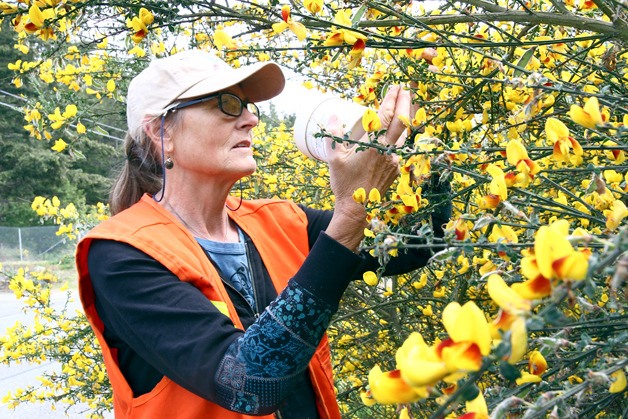It looks so pretty — showy purple-pink flowers, long slender seed pods, soft hairs all over. But it’s the most invasive weed Whidbey Island’s wetlands have ever faced.
It’s called hairy willow-herb, and Janet Stein wants it dead.
“Hairy willow-herb spreads so quickly that it displaces our native wetland plants, which reduces diversity of food and habitat,” said Stein, Island County’s noxious weed coordinator.
“That’s bad for wildlife.”
No one knows how the plant, which looks similar to native fireweed, got a foothold in the wetlands around Crockett Lake 20 years ago. It was once sold as an ornamental plant, and airborne seeds may have blown there.
However it happened, no controls were imposed, and it has spread from an initial 20-square-foot area to 100 acres. Now the most prevalent plant at Crockett Lake, it has also begun growing around Oak Harbor’s 25-acre Swan Lake area, and Stein said she’s seen it in roadside ditches north of there.
“The seeds may be coming up on winds from the south,” Stein said. “It’s scary to see.”
The plant is such a threat that landowners are required by state law to eliminate it — though in Island County, there’s no enforcement.
“We just try to educate people and try to get them to cooperate,” Stein said.
The county plans to seek $25,414 from the Conservation Futures Fund for two years of noxious weed control work, including a survey and mapping, at Swan Lake.

“It is imperative” to contain the hairy willow-herb there, the proposal says.
Most plants have only one way to propagate. The hairy willow-herb spreads not only through seeds but also through a vigorous system of fast-growing roots. The root density can keep other plants’ seeds from germinating and can even impede water flow, altering the wetlands’ hydrology.
Eliminating the plant at Crockett Lake would be “a monumental task,” Stein said, just because of the infestation’s scale. Actually killing it isn’t that hard. It can be dug out fairly easily, it’s susceptible to common herbicides, and the larvae of one insect — the Mompha epilobiella moth — like to eat its foliage and flower buds, though not much research has been done on their effectiveness.
Already doing good work on the island, she said, is a weevil, Bruchidius villosus, whose larvae eat the seeds of the island’s other widespread noxious weed, Scotch broom. The larvae are ruining up to 87 percent of the seeds on the plants they occupy, which over time will slow the weed’s spread.
If the county gets the money it has requested, it will likely hire workers from the Washington Conservation Corps, an AmeriCorps program, to dig up the hairy willow-herb, Stein said.


